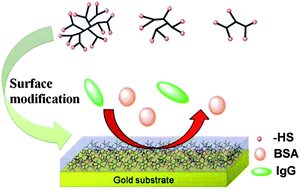To elucidate the effect of polymeric branched architecture on the protein resistant properties, the protein adsorption behaviour of polymers with different branched architectures on a gold surface was investigated. A series of poly((S-(4-vinyl) benzyl S′-propyltrithiocarbonate)-co-(poly(ethylene glycol) methacrylate))s (poly(VBPT-co-PEGMA)s) with different branched architecture were prepared by reversible addition-fragmentation chain transfer (RAFT) copolymerization, and then grafted onto a gold surface via thiols obtained from aminolysis reaction. With the increase of polymeric branched architecture, the thiol content of poly(VBPT-co-PEGMA)s increased, resulting in the formation of a highly uniform film with high stability and multifunctionality on the gold substrate. On the other hand, incubation of the poly(VBPT-co-PEGMA)-coated surface with bovine serum albumin (BSA) and immunoglobulin (IgG) showed that the protein resistant properties of the polymer-coated surface were enhanced with the decrease of branched architecture. After surface coating with branched poly(VBPT-co-PEGMA) onto a gold surface, the adhesion and proliferation of Hela cells were inhibited efficiently. By only adjusting the branched architecture of polymers on a substrate, the high protein resistance and multifunctionality can be integrated together, realizing the optimization of nonfouling properties of polymer-coated surface.

